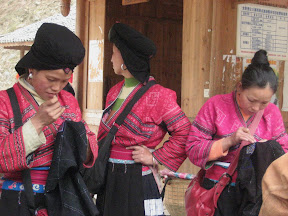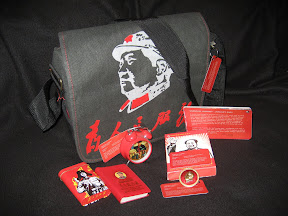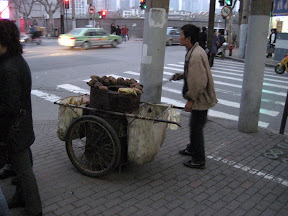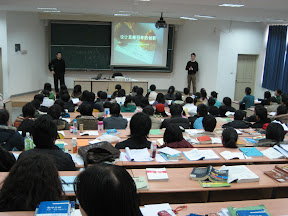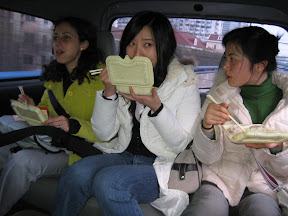Shanghai is so raw, so beautifully organic and imperfect. This makes a walk through old town in PuXi (literally, the area west of the Huang Pu river) just wonderfully delightful. The contrast is even more extreme when PuXi is compared to PuDong (the area east of the Huang Pu River), which seems so George Jetson, sterile, and well, western and modern.
On a chilly clear Saturday morning, Ela’s friends Ben (design professor at Olin) and Connie schlepped out with us to the markets in Old Town. We started off at the HuaNiao Market where one can find crickets, birds and other odd sounding animals.
As someone who had two pet cockroaches (named Sid and Dis) as pets during her college days, I was still absolutely astounded by the crickets here. Ranging from 20 yuan to upwards of 1000 yuan depending on size, coloration and breed, crickets are well loved here. The nicer stalls had crickets in transparent glass jars with beautifully carved lids. The less legitimate ones have their crickets inside used tuna cans with the price labels on the lid. The higher the price, the more scared I was of peeking underneath the hood for fear of what could leap out at me. We also discovered an entire world of tools to support cricket fighting. I picked up a pair of bamboo tweezers, a bamboo ‘tunnel’ that you would sweep your cricket into in order to transport him safely out of the jar, and a hollow bamboo tube for keeping scraggly sticks that crickets like biting onto.
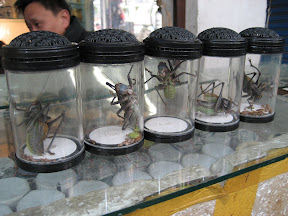
Similarly, birds and dogs and cats were all available for purchase in the vicinity. Depending on how deep your pockets are, or how much you love your pet, you can buy a correspondingly plain or extravagant cage carved from wood. For dogs, there is an entire business of clothing, including doggie ponchos to keep your furry friend from getting wet during the rainy season. Having a pet is a really new thing for China, but my Chinese conversation teacher Zou tells me that it is because of the increasing numbers of young people who live and work alone here, away from their families.
Our wandering soon led us to FangBang Lu, which takes the cake for shocking sights. If you are an animal rights activist, you might want to stop reading here. What you see in the photograph below is indeed a pile of frozen giant eel sitting in the middle of the street. Behind that pile is the proud stall owner with sample sections of meat flayed open for you to examine.
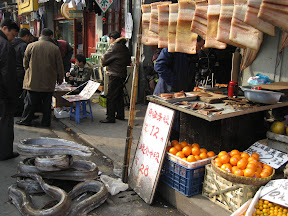
Down the street not far away is a young man selling something that looks a lot like a fancy Zyliss mandolin cutter. He is convincingly demonstrating, in the middle of the street, at a very legitimate looking stall, how well his tools work for making vegetable slices and julienne bits. But look to the left and right more closely. Yes, the budding entrepreneur next to him is selling porn and sex toys, out in the middle of broad daylight. Even more curious is the fact that most of the men on the street are excitedly hovering around a street vendor selling business and software magazines, rather than the porn.
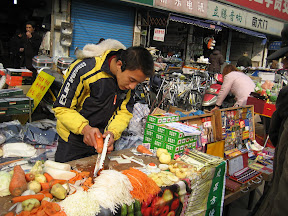
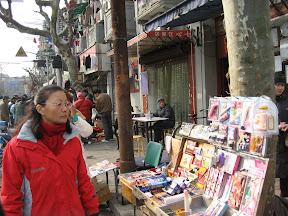
Further down the street, someone has an open suitcase full of spools of thread, presumably for sale. Next to him there’s a man with a Zippo lighter sized blow torch which can melt metal. And then nearby, on a piece of cloth, there’s someone selling a bear claw on a piece of cloth.

Fangbang Lu in Old Town ain’t no organized flea market, but everyone seems to be coming out of the woodwork to sell one thing or another.
After Ben and Connie took off for the airport, Ela and I walked further into the Old Town jungle. Ela had ran past the food markets during the daytime previously and suggested meandering through the area again. As darkness fell, the colors of the meats and vegetables in the open air stalls became even more intense given that any electrical lighting was focused on illuminating the goods to be sold. Fruits and vegetables spilled into the streets, making it impossible for anything larger than a cyclist or pedestrian to make their way through the alleyways. Chinese beer was sold out of large clay pots, like it has been done for centuries. Nursing our sweet tooth, every few stalls or so, Ela and I bought snacks to try, often fresh out of the ovens and steamers.
What a delight it was to sample balls of rice with red bean paste, chinese ‘egg mcmuffins’, flaky cakes with peanuts and sunflower seed filling (which Ela thought was pork the last time she had it), black sesame and peanut brittle, and handfuls of crunchy and chewie things that I cannot describe. If it weren’t for our fingers freezing off, we would have skipped dinner.
With Shanghai’s push for modernity, for clean sleek buildings and shiny new metro lines, I hope it maintains some of this imperfection and rawness. The interactions with the people and the goods in these markets, which are so poo-pooed these days, are so much more organic and engaging than at places like the Superbrand Mall (deemed a ‘model unit’ by the local government). Everything is out in the open for one to see and experience in its purest form. There are no closed doors behind which things are processed and prepared.
What would our malls and grocery stores in America be like if products were allowed to spill out a little more? What if physical boundaries of space were less delineated? What if zoning laws were less rigid? What if more people could set up their own lemonade stands anywhere they want?

